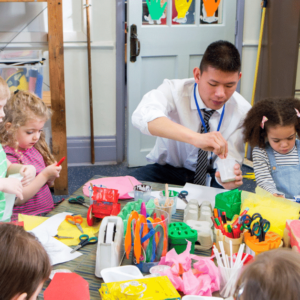Breaking Into the Classroom : Speech Service Delivery in the Schools
$15.00

Course Type: Video – 1 hour
ASHA Course Code: Service Delivery Associated with Speech, Language, Hearing and Related Disorders – 7010
Learn how to break into the classroom and contribute significantly to the literacy and academic achievement of students with communication disorders.
Approximately 70% of speech-language pathologists use a pull-out model (ASHA, 2012). However, we are missing crucial opportunities to improve our relationships with teachers, have our therapy map directly over academic goals, and reduce our therapy planning by using the content and materials that teachers are developing each week. Break into your school’s classrooms and reap these rewards.
Additional Information
| Population | School Age |
|---|---|
| Topics | SLP Professional |
| Duration | 1 hour |
| Credit | .1 Continuing Education Unit |
| Format | Video |
Financial Disclosure: Phuong Lien Palafox, M.S., CCC-SLP was an employee of Bilinguistics. Bilinguistics receives royalty payments for online courses.
Non-Financial Disclosure: Phuong Lien Palafox does not have any non-financial relationships to disclose.
SLPs juggle an ever-increasing workload. For our own self-preservation, we need to think more creatively about service-delivery methods.
Certainly, pull-out services are effective for some students, but they should be used on a finite timeline. More broadly, we need to align our services to the general education curriculum, providing more “push-in” services in the classroom.
Why push in? Bottom line: It helps us work more efficiently and effectively. We can have a greater impact on our students’ skills with the same amount of our time. Classroom-based services allow us to:
Maximize our impact. Teachers have 28 percent of our student’s waking time (1,260 hours) in a year. Traditional methods give SLPs approximately 30 hours annually. Let’s build capacity by helping teachers to use strategies all day to make a lasting impact.
Promote generalization. Let’s face it—children with disabilities aren’t the best at generalizing a skill to a new setting. But when we provide intervention using classroom content in the students’ natural setting, and consistent strategies are carried over throughout the day, our students use the skills they’ve learned when they really need them, not just in the therapy room.
Provide strategies for students receiving response-to-intervention. When we are in the classroom, we can provide intervention for at-risk students so they will not become a student on our caseload with an individualized education program.
Build rapport and community with teachers. Our relationships with teachers improve dramatically when they feel like we are “one of them,” rather than the “speech lady” who pulls their students out during instruction. And when they understood and respected us, they were much more likely to be listening and learning during classroom intervention rather than using the time to check e-mail.
And most important, we initiate change in our students that teachers can see in the classroom every day, rather than the incremental change that we see in our data charts in the therapy room. As one first-grade teacher said, “I’ve had students pulled for speech. [But] with this model, I saw the most improvement I’ve seen.”
Participants will be able to:
Describe how speech pathologists can providing unique contributions to curriculum.
Describe evidence-based intervention approaches for working in the classroom.
Address literacy, writing, and vocabulary goals within the context of communication goals.
Demonstrate how to maintain positive interactions with educational professionals while interacting in the classroom.
Time-Ordered Agenda
Breaking Into the Classroom : Speech Service Delivery in the Schools
05 minutes: Introduction
10 minutes: Providing unique communication contributions to curriculum
15 minutes: Presentation of research on communication intervention in the classroom
10 minutes: Addressing literacy
10 minutes: Addressing writing
10 minutes: Addressing vocabulary
10 minutes: Case study examples on how to interact and collaborate with educational professionals in the classroom
05 minutes: Course quiz and evaluation
80 minutes total
Need CEUs?

 Share
Share
 Tweet
Tweet
 LinkedIn
LinkedIn
 Pin
Pin
 Email
Email





